It’s fish-eat-fish on the reef, where almost everything that swims is both a hunter and hunted. But mixed in with all these ruthless carnivores and omnivores are some marine vegetarians. They play a small but vitally-important role in the marine environment. Their grazing keeps algae from overgrowing reefs and helps keep seagrass beds tidy and vibrant. These plant-eaters are present on every dive site surrounding Wakatobi Dive Resort, so let’s meet some of the region’s most interesting undersea vegetarians.
Get off my lawn
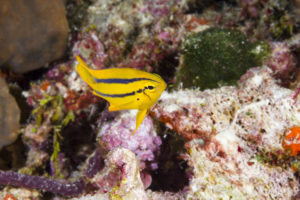
Some damselfish don’t just graze the reefs of Wakatobi, they farm them. These aquatic agrarians cultivate a personal algae patch by repeatedly biting live coral tissue. This creates skeletal lesions that filamentous algae then colonize. The damselfish’s polyp-nipping habits do actually cause some harm to the corals. But when the ecosystem is in balance, plenty of predators such as lizardfish, small jacks, sweetlips and frogfish prey on damselfish and keep populations in check. This is just one more reason it’s important to protect the reefs and maintain the marine no-take zones that ensure natural order.
Beware this hare
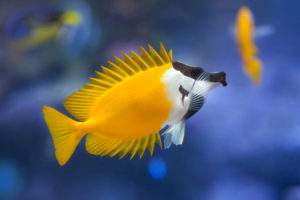
It’s easy to see how rabbitfish got their name. The combination of an elongated snout, large eyes and small mouths filled with dainty teeth evokes a certain resemblance to the long-eared mammal. Like their terrestrial namesake, rabbitfish emerge from sheltering nooks when the sun rises and spend their days placidly grazing on algae. There are 29 known species of rabbitfish in the waters around Wakatobi, and some can grow up to 1.6 feet long (.5 m). Youngsters often hang out in schools but rabbitfish pair up as they mature. Scientists think they mate for life. Though seemingly vulnerable, rabbitfish do have some survival tricks. The first is an ability to rapidly change color, transforming their bright markings and stripes into a dull, splotch pattern that resembles military camouflage. If concealment doesn’t work, the real deterrent is a line of venomous, spine-like fins that they can raise to discourage attacks.
A celebrity sighting
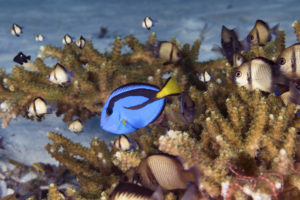
Yellow tail and yellow-tipped pectoral fins; a small, pouty mouth; a two-toned blue and indigo body — yep, you’ve found Dory. Paracanthurus hepatus to be more precise, though this member of the surgeonfish family has enough common names to give anyone memory loss. Stick with regal blue tang to avoid any confusion with the all-blue Caribbean cousin. These fish are social, often traveling in pairs or groups. The juveniles are actually bright yellow with blue spots. As they mature and adopt their signature color patterns, regal blue tangs also acquire a taste for algae and become an important member of the reef-cleaning crew. They sport poison-tipped and razor-sharp spines that give would-be predators reason to pause. If that doesn’t work, the regal may play dead by lying on its side and remaining motionless until the threat passes.
Trimming the grass
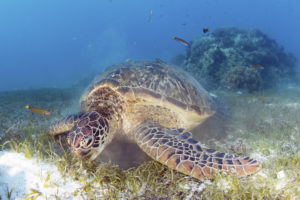
Green sea turtles are common on Wakatobi reefs, and you’ll often encounter youngsters in the seagrass beds close to the beach. Juveniles spend their early months nibbling on sponges, crabs and worms, but as they grow, they switch to algae and seagrass. And that’s a good thing, because their grazing helps the plants rather than harming them. Turtles don’t just grab a mouthful of grass; they focus on the younger and more nutritious mid-sections of the blades. They bite off older and less nutritious top portions of grass and leave them to float free and drift away. This close cropping encourages new growth. When turtles graze, they actually increase the productivity and nutrient content of the grass bed.
Saving for a sunny day
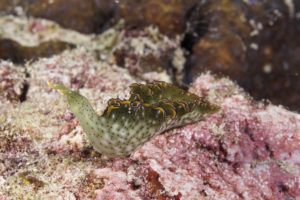
The name says it all. Sap-sucking sea slugs literally suck the juice out of algae. Most of the time, they simply digest the fodder, but certain shell-less species can transfer the algae’s living chloroplasts to their own bodies, and literally feed themselves off of sunlight. Scientists are uncertain how these simple slugs perform the complex genetic transfer known as kleptoplasty. What is known is that the slugs would rather just suck on the algae, and only revert to photosynthesis when other food sources dry up.
A fishy character
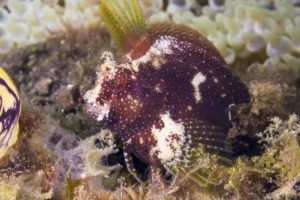
If Dr. Seuss had been a diver, he’d have loved the starry blenny. The spots, the antenna-like stalks that rise above the forehead, and the expressive and protruding eyes are all features a cartoonist would appreciate. Add in the seemingly bemused demeanor when this little fish poses with its wide mouth agape and you have a subject worth watching. And, chances are, the starry blenny will be watching back, with its eyes moving independently as it scans the reef. These fish may remain motionless for long periods then suddenly begin flitting about like a hyper preschooler while conducting a remarkable series of color and pattern changes. The starry blenny uses its comb-shaped teeth to scrape bits of algae from rocks and corals, a habit that has earned it the nickname “starry lawnmower blenny.”
These vegetarians are just some of the unique and intriguing creatures you’ll see on the reefs at Wakatobi. Plenty more fascinating stories await, so perhaps you’ll have a chance to meet some of Wakatobi’s vegetarians for yourself in the near future.
The post The Undersea Vegetarians of Wakatobi appeared first on Scuba Diver Life.
from Scuba Diver Life http://ift.tt/2GM8xle
No comments:
Post a Comment